
Kalmia latifolia, the mountain laurel, calico-bush, or spoonwood, is a species of flowering plant in the heath family Ericaceae, that is native to the eastern United States. Its range stretches from southern Maine south to northern Florida, and west to Indiana and Louisiana. Mountain laurel is the state flower of Connecticut and Pennsylvania. It is the namesake of Laurel County in Kentucky, the city of Laurel, Mississippi, and the Laurel Highlands in southwestern Pennsylvania.

Pinus contorta, with the common names lodgepole pine and shore pine, and also known as twisted pine, and contorta pine, is a common tree in western North America. It is common near the ocean shore and in dry montane forests to the subalpine, but is rare in lowland rain forests. Like all pines, it is an evergreen conifer.

Andromeda polifolia, common name bog-rosemary, is a species of flowering plant in the heath family Ericaceae, native to northern parts of the Northern Hemisphere. It is the only member of the genus Andromeda, and is only found in bogs in cold peat-accumulating areas. Andromeda glaucophylla is a synonym of A. polifolia var. latifolia.

The plant tribe Phaseoleae is one of the subdivisions of the legume subfamily Faboideae, in the unranked NPAAA clade. This group includes many of the beans cultivated for human and animal food, most importantly from the genera Glycine, Phaseolus, and Vigna.
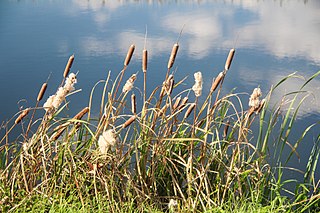
Typha latifolia, better known as broadleaf cattail, is a perennial herbaceous plant in the genus Typha. It is found as a native plant species in North and South America, Eurasia, and Africa.

Sagittaria latifolia is a plant found in shallow wetlands and is sometimes known as broadleaf arrowhead, duck-potato, Indian potato, katniss, or wapato. This plant produces edible tubers that have traditionally been extensively used by Native Americans.

Silene latifolia subsp. alba, the white campion is a dioecious flowering plant in the family Caryophyllaceae, native to most of Europe, Western Asia and Northern Africa. It is a herbaceous annual, occasionally biennial or a short-lived perennial plant, growing to between 40–80 centimetres tall. It is also known in the US as bladder campion but should not be confused with Silene vulgaris, which is more generally called bladder campion.

Silene vulgaris, the bladder campion or maidenstears, is a plant species of the genus Silene of the family Caryophyllaceae. It is native to Europe, temperate Asia and northern Africa and has been introduced to other parts of the world, particularly North America. It is widespread in North America, where it is a common wildflower in meadows, open woods, and fields.
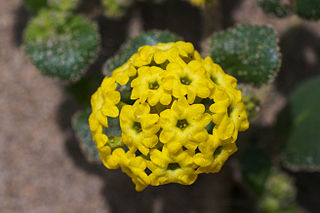
The perennial flower Abronia latifolia or Abronia arenaria is a species of sand-verbena known commonly as the coastal, or yellow sand-verbena. It is native to the west coast of North America, from southern California to the Canada–United States border.
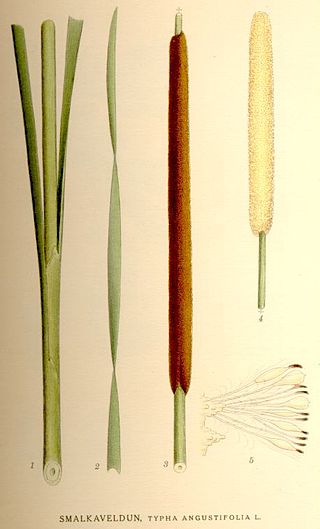
Typha angustifolia L. is a perennial herbaceous plant of genus Typha. This cattail is an "obligate wetland" species that is commonly found in the northern hemisphere in brackish locations.

Rhynchosia, also known as snoutbean, is a genus of plants in the family Fabaceae. There are several different complexes within the genus, including the Senna complex.
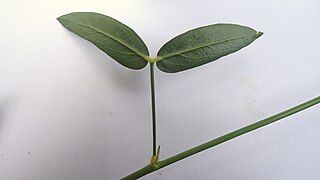
Zornia latifolia is a species of flowering plant in the legume family, Fabaceae. It is native to South America. Its distribution may extend into Central and North America. It is also known as a naturalized species in tropical western Africa. The plant is known commonly as maconha brava.

Orbexilum, commonly called leather-root, is a genus of flowering plants in the legume family (Fabaceae). They are native to North America, where they are found in the United States and Mexico, south to Chiapas.
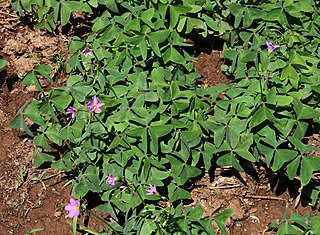
Oxalis latifolia is a species of flowering plant in the woodsorrel family known by the common names garden pink-sorrel and broadleaf woodsorrel. It is native to Mexico and parts of Central and South America.

Lavandula latifolia, known as broadleaved lavender, spike lavender, aspic lavender or Portuguese lavender, is a flowering plant in the family Lamiaceae, native to the western Mediterranean region, from central Portugal to northern Italy (Liguria) through Spain and southern France. Hybridization can occur in the wild with English lavender.

Rhynchosia minima is a species of flowering plant in the legume family known by the common names least snout-bean, burn-mouth-vine, and jumby-bean. It can be found on every continent. It is naturalized in Hawaii.

Olyra latifolia, commonly known as carrycillo, is a species of bamboo in the grass family Poaceae. It occurs in Mexico, Central and South America, and in sub-Saharan Africa. It is a common species, up to 5 m (16 ft) tall, growing prolifically in rainforests, particularly near the margins.

Sagittaria rigida, the sessilefruit arrowhead or Canadian arrowhead, is an aquatic plant species native to Canada and to the United States and also naturalized in Great Britain. It grows in shallow waters along the edges of ponds and streams. What is really interesting is that it has narrow oval leaves rather than the iconic arrowhead shaped leaves of species like the Sagittaria latifolia. it has sessile female flowers, which is where it gets its name from. Its flowers are very similar to other plants in the Sagittaria family, with three white petals. It grows "potato" like tubers which can be eaten. Gathering any tubers from the Sagittaria family can be dangerous if gathered from polluted water.

Machaeranthera asteroides, the fall tansyaster, is a North American species of plants in the sunflower family. It is native to the southwestern United States and northern Mexico.

Rhynchosia tomentosa, commonly known as the twining snoutbean is a species of plant in the legume family. It is native to the Southeastern United States, where it is primarily found in dry, open woodlands and sandhills.




















